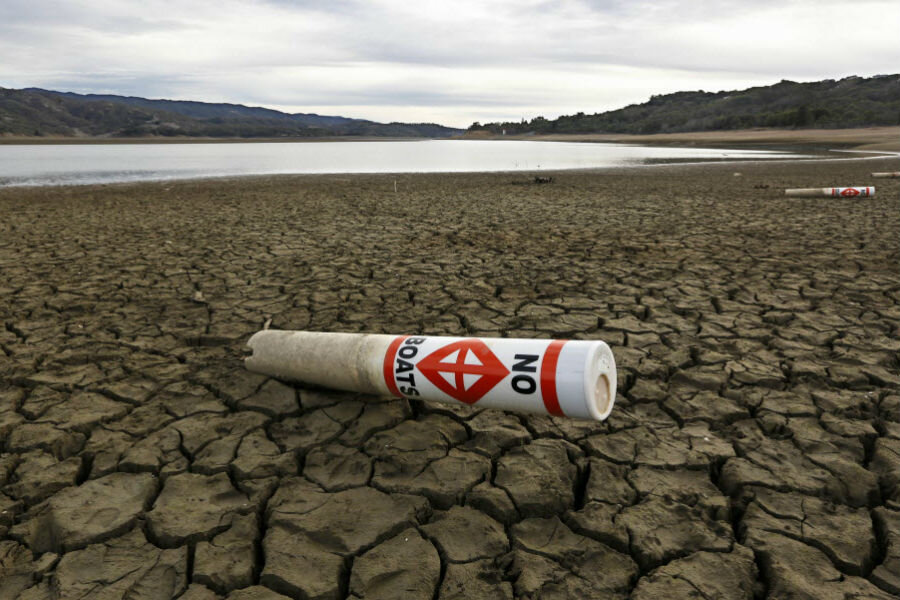Return of the Dust Bowl? Climate change study highlights how West must adapt.
A prolonged period of Dust Bowl-like conditions in the second half of this century could severely test strides made toward conserving scarce water supplies in the Western United States and central Plains, according to a new study.
If greenhouse-gas emissions aren't brought to heel, the study suggests, these regions face an 80 percent risk of seeing a severe drought lasting a generation or more.
The results are the latest in a growing body of research suggesting that farmers and city-dwellers alike are going to have to double down on efforts to use water more efficiently, says Brian Richter, chief scientist of water markets for The Nature Conservancy in Arlington, Va.
Cities and farms in many parts of the Western United States and central Plains, mired in a prolonged period of stubborn droughts, have already made progress, with some of these efforts dating back to the 1960s and '70s. Indeed, water use in the US today is about the same – or is slightly lower – than it was in 1980, despite a growing population and rising farm production, according to a US Geological Survey report issued earlier this year.
“Clearly we're doing something right,” says Mr. Richter.
But it's equally clear that the efforts aren't enough, he adds, particularly in the country's semiarid regions. There, populations are expected to rise and the snowpacks that provide crucial summer meltwater are expected to shrink.
Many of the tools needed to cope are familiar, such as landscaping around homes with native vegetation. Some are more technological, such as desalination plants in coastal communities or facilities that wring potable water from human waste.
The current drought in California is just a taste of what the new study, released Thursday in the open-source, online journal Science Advances, says is likely to be in store. But strides made in the Southwest in recent years point to how regions can adapt – and hint at what might lie ahead.
The current drought "puts the Southwest in a very unique position to play a leadership role" in charting a path toward coping with megadroughts, said Toby Ault, a climate scientist at Cornell University and a member of the team conducting the study.
Even without global warming, the issue of dwindling water resources in parts of the West and central Plains have been coming to a head. Underground aquifers have are being drained at an unsustainable rate to support farms and, to a lesser extent, urban growth. During the course of the past century more water has been allocated to states drawing from the Colorado River than the river can deliver. And populations have risen.
Moreover, past research has shown that, in the distant past, the western US has endured droughts more severe and longer than any experienced since Columbus's arrival in the New World. An unusually warm period between 1100 and 1300 AD saw at least three "megadroughts" in the climate system. These droughts were due to natural variability, notes Benjamin Cook, a researcher at NASA's Goddard Institute for Space Studies in New York and the lead author of the study.
The new study simulates two separate scenarios: one that assumes a modest reduction in greenhouse-gas emissions and one that assumes no change to current policy.
The study found the changes in rain and snowfall in semiarid regions such as the Southwest and central Plains fit a more global pattern of the wet getting wetter and the dry getting drier. But evaporation also increased markedly. Even in spots that got more precipitation than expected, according to the results, evaporation would offset the extra moisture.
Under both emissions scenarios the researchers considered, "using their definition of drought we fall off a cliff," says Peter Gleick, president and co-founder of the Pacific Institute, which focuses on water-resource issues. "Our cities will survive, our industries will survive, but our agricultural systems are going to be devastated. And probably, unless we're smart, our ecosystems will be devastated."
Historically, cities in the West and Plains have coped with a scarcity of water by drawing down ground or surface water, then by looking for more-distant sources.
But "we're running out of reach in terms of new sources to be raided to try to balance the water equation in the West," Mr. Richter explains, referring to proposals to pipe water from Alaska or Canada to the West.
He says he is reluctantly coming to accept the possibility of desalination plants as one answer, though they are expensive, energy intensive, and produce large quantities of concentrated brine that requires disposal.
Given projections for population growth, balancing the water equation will require more intense efforts to shift water resources from farming to urban areas, he says.
Cutting those deals will require bridging significant cultural and social divides.
Given the history of conflicts over water in the region, "there's great fear in the agricultural community that the cities are so politically and financially powerful that they're going to figure out some way to wrest water out of the agricultural areas," Richter explains. Farmers "are very skeptical and very suspicious about even entering into a partnership" with cities.
Yet successful examples exist. For example, San Diego inked a deal with farming interests in the Imperial Valley under which the city pays the farmers to adopt conservation measures, such as reducing water losses due to unlined irrigation canals. In exchange, the city gets the water saved.
The approach, in place since 1998, is expected to provide 40 percent of the city's water by 2020, according to a study on water conservation approaches published two years ago in the journal Water Policy.






